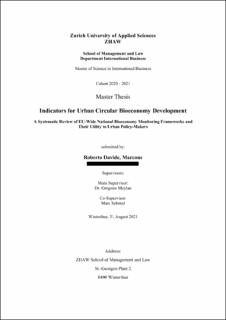Please use this identifier to cite or link to this item:
https://doi.org/10.21256/zhaw-24678Full metadata record
| DC Field | Value | Language |
|---|---|---|
| dc.contributor.advisor | Meylan, Grégoire | - |
| dc.contributor.advisor | Schmid, Marc | - |
| dc.contributor.author | Marcone, Roberto Davide | - |
| dc.date.accessioned | 2022-03-30T13:23:45Z | - |
| dc.date.available | 2022-03-30T13:23:45Z | - |
| dc.date.issued | 2021 | - |
| dc.identifier.uri | https://digitalcollection.zhaw.ch/handle/11475/24678 | - |
| dc.description.abstract | By combining principles of circularity with a transition to regenerative resource usage, the 2018 European bioeconomy strategy set a new vision for the continent’s sustainable development. With it, the EU Bioeconomy Monitoring System, an indicator set used to monitor the progress of the circular bioeconomy, was launched. It is the most comprehensive such tool and its conceptualization involved the collaboration of several EU member states. For a successful, synergistic and efficient transition of the European economy to a circular bioeconomy, policy and action must indeed be aligned throughout governance levels. While both the European and national efforts are reflected within the Monitoring System, it remains unclear whether national strategies and indicator sets are also suitable for urban governments to align with. As urban policy-making takes the role of implementing the bioeconomy strategies, it is vital that it does not diverge from national and international efforts, causing inefficiencies and adverse effects on the bioeconomy transition. This thesis aimed to investigate EU-wide national bioeconomy strategies and to examine the composition, features and topical coverage of their bioeconomy measuring tools. In a second step, the suitability of these tools as guidance for the development of consistent urban indicator sets was evaluated. The national bioeconomy strategies were collected and appraised through a systematic review process, and their indicator sets’ forms and contents were examined. First, a factsheet and a quality appraisal of the single indicators gave insight into the construction of the indicator sets, then a heatmap of topical coverage was created showing areas of the bioeconomy tackled by the instruments. Of the 27 member states, only nine had a dedicated bioeconomy strategy, and four among them proposed an indicator set. Assessing these sets revealed that particularly the tools proposed after the issuance of the 2018 bioeconomy strategy followed indicator development standards rigorously. They also included circularity principles in their notion of bioeconomy and combined indicators for a profound and multi-faceted analysis with substantial informative and policy-relevant value. These factors strongly improve the potential for alignment and coherence with urban-level bioeconomy monitoring efforts. Nonetheless, urban governments cannot use them at face value, as the goal-setting and therefore the selection of single indicators, differs across policy levels. Although it is not the aim of national measuring tools to perfectly provide for urban needs, the findings of this thesis give insight into the importance of and ways how national bioeconomy policies can support a uniform circular bioeconomy transition across the EU. | de_CH |
| dc.format.extent | 98 | de_CH |
| dc.language.iso | en | de_CH |
| dc.publisher | ZHAW Zürcher Hochschule für Angewandte Wissenschaften | de_CH |
| dc.rights | https://creativecommons.org/licenses/by-nc-nd/4.0/ | de_CH |
| dc.subject.ddc | 338.927: Umweltökonomie und nachhaltige Entwicklung | de_CH |
| dc.title | Indicators for urban circular bioeconomy development : a systematic review of EU-wide national bioeconomy monitoring frameworks and their utility to urban policy-makers | de_CH |
| dc.type | Thesis: Master | de_CH |
| dcterms.type | Text | de_CH |
| zhaw.departement | School of Management and Law | de_CH |
| zhaw.publisher.place | Winterthur | de_CH |
| dc.identifier.doi | 10.21256/zhaw-24678 | - |
| zhaw.originated.zhaw | Yes | de_CH |
| Appears in collections: | MSc International Business | |
Files in This Item:
| File | Description | Size | Format | |
|---|---|---|---|---|
| Master Thesis_Roberto Davide MARCONE.pdf | 1.48 MB | Adobe PDF |  View/Open |
Show simple item record
Marcone, R. D. (2021). Indicators for urban circular bioeconomy development : a systematic review of EU-wide national bioeconomy monitoring frameworks and their utility to urban policy-makers [Master’s thesis, ZHAW Zürcher Hochschule für Angewandte Wissenschaften]. https://doi.org/10.21256/zhaw-24678
Marcone, R.D. (2021) Indicators for urban circular bioeconomy development : a systematic review of EU-wide national bioeconomy monitoring frameworks and their utility to urban policy-makers. Master’s thesis. ZHAW Zürcher Hochschule für Angewandte Wissenschaften. Available at: https://doi.org/10.21256/zhaw-24678.
R. D. Marcone, “Indicators for urban circular bioeconomy development : a systematic review of EU-wide national bioeconomy monitoring frameworks and their utility to urban policy-makers,” Master’s thesis, ZHAW Zürcher Hochschule für Angewandte Wissenschaften, Winterthur, 2021. doi: 10.21256/zhaw-24678.
MARCONE, Roberto Davide, 2021. Indicators for urban circular bioeconomy development : a systematic review of EU-wide national bioeconomy monitoring frameworks and their utility to urban policy-makers. Master’s thesis. Winterthur: ZHAW Zürcher Hochschule für Angewandte Wissenschaften
Marcone, Roberto Davide. 2021. “Indicators for Urban Circular Bioeconomy Development : A Systematic Review of EU-Wide National Bioeconomy Monitoring Frameworks and Their Utility to Urban Policy-Makers.” Master’s thesis, Winterthur: ZHAW Zürcher Hochschule für Angewandte Wissenschaften. https://doi.org/10.21256/zhaw-24678.
Marcone, Roberto Davide. Indicators for Urban Circular Bioeconomy Development : A Systematic Review of EU-Wide National Bioeconomy Monitoring Frameworks and Their Utility to Urban Policy-Makers. ZHAW Zürcher Hochschule für Angewandte Wissenschaften, 2021, https://doi.org/10.21256/zhaw-24678.
Items in DSpace are protected by copyright, with all rights reserved, unless otherwise indicated.